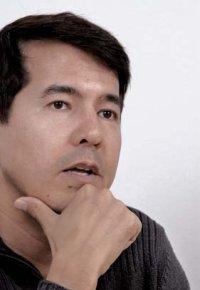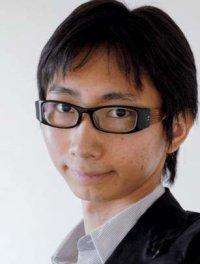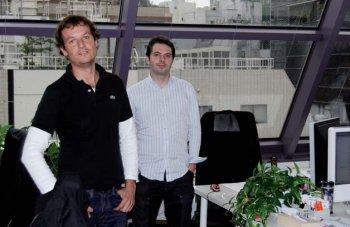Web Development: New Breed
By Michael Condon
J@pan Inc takes a look at some of Tokyo’s most exciting Internet innovators.
 Kristopher Tate believes Japan’s Web infrastructure may give it the edge in the next stage of the Internet’s evolution.
Kristopher Tate believes Japan’s Web infrastructure may give it the edge in the next stage of the Internet’s evolution.
Photography by Sarah Noorbakhsh.
The Philosopher
Kristopher Tate is a communicator. At the age of five he learned his second language—and it wasn’t Spanish or French. That was when he started communicating with computers: his first programming language was Think C. At the age of 17 Tate created Zooomr—a photo-sharing Website that Silicon Valley God-maker Michael Arrington, from IT blog Techcrunch, labeled as “Flickr on Steroids.” During this time, Tate fed his love of linguistics, at times spending up to 16 hours per day learning Japanese. In 2007 after the owner of Flickr, Yahoo, declared all-out war on the young entrepreneur, Tate decided to head to the one place Yahoo couldn’t touch him—Japan. Due to a non-compete rule that Yahoo has with Yahoo Japan, Tate was able to take his site to Japan and open it up to a potential 50 million users via deals with the big three mobile network providers as well as Willcom and eMobile.
Much has been made of the wunderkind’s rise to fame—his age not being the least of the impressive list of facts about the young American. The 20-year-old now believes he sees the future of communication. Hidden away in Tokyo’s fashionable Harajuku district, Tate has been working with his band of loyalists to create what he believes will be the future of intra-office communication. The project, Bluebridge, is still in its beta stage and will be launched within the next few months. Tate says the Website will create a new way for coworkers to communicate with each other so that tasks can be better allocated and time can be managed more efficiently.
But Tate says that his company, which uses the same name as the Website, is about much more than the current project. He sees Japan as the next frontier in Web development and he wants to be part of the next stage in its evolution. “It wasn’t that I wanted to change Japan, in reality I wanted to work with people within Japan…and extend upon it to build a new industry that circles the world.” Tate says that what Japan lacks in innovative Web developers, it makes up with infrastructure and mobile-web literacy. Now he believes it is time to nurture a Silicon Valley-like community where innovation is promoted and the small independent developers can find partners with the big companies—something which traditionally hasn’t happened in Japan.
“Bluebridge is more about building a community… we want to open up to developers, we can see the opportunity and we want to usher in a new industry, bringing individuals and big developers together—anyone can be a player, anyone can change the world.”
The Educators
Andrew Smith Lewis feels like his company has been reborn. Smith Lewis, with partner Eric Young, are by no means new in the Tokyo IT scene. They started back in the early ’90s and weathered the IT bust of the early 2000s. Neither is the basic premise of their new program—they have been selling essentially a B2B version of it for years now.  Andrew Smith Lewis of Cerego But what they are about to do with it is something different. And it’s significant enough for them to have been able to raise about $20 million in capital, mainly from private investors (only $1 million is venture capital).
Andrew Smith Lewis of Cerego But what they are about to do with it is something different. And it’s significant enough for them to have been able to raise about $20 million in capital, mainly from private investors (only $1 million is venture capital).
“I kind of feel like a phoenix from the ashes—we’ve been reborn. We wandered in the desert for a while,” Smith Lewis says.
Smith Lewis and Young are the cofounders of Cerego, an IT company, started in 1995 as a thinktank, created to develop learning efficiency programs. In 2000 the organization morphed into a tech company developing learning software for staff of Japanese companies. Now, the company is about to go global with the launch of www.iknow.co.jp — a free wiki-style learning program that can be adapted to essentially any content. The program, which was released in beta-form and is for Japanese wanting to learn English, takes the principles of the B2B memory retention software programs the company had developed and enables them to be used and adapted by the average PC user for free. The beta version already has more than 280,000 active Japanese users while the new English version for those wanting to learn Japanese had 10,000 users after two weeks. In September it clocked 350,000 unique visitors, up 40 percent from just two months prior. A version developed by the US State Department for its employees to learn Chinese has already been developed, while more versions are to be developed by third parties on the proviso that they be released to the public.
 Eric Young of Cerego
Eric Young of Cerego
Iknow.co.jp’s genius is that it combines algorithms based on cognitive science and neuroscience (some of which are patented by Cerego) with a social networking platform that enables users to interact and even create their own lessons. The lessons can be embedded in blogs and other Websites adding to the viral nature of the program. With the global e-learning market estimated to top $52 billion in 2010, it’s little wonder that Cerego has been able to find major investment.
“Education is something that hasn’t radically changed—compared to industries like hospitality etc., education has remained essentially the same over the last few decades.” Smith Lewis says he looked at the multi-million dollar English conversation industry in Japan and saw the potential for a B2C model for their learning software.
“How much is spent on the eikawa (English conversation) industry each year? Hundreds of millions. And how many people can speak English here?” Smith Lewis says. “We thought: let’s disrupt this market and give something back.” But how does it make money? At its heart the Website offers what every advertiser dreams of—a memory retention algorithm— imagine if every non-native English speaker who learned the word “coffee” saw a picture of a Starbucks coffee mug every time the word popped up…
The Programmer
Taisuke Fukuno envisages a world where anyone has the tools to create their own applications—a post-Web 2.0 world, where users don’t just create content but create programs to suit their individual needs and then share them with friends: or ‘programming 2.0,’ as he calls it.
 Jig.jp’s Taisuke Fukuno
Jig.jp’s Taisuke Fukuno
“My dream is for all people to become programmers—a programmer can create what he wants,” says Fukuno. “Programming is a kind of language, it’s a very useful way to communicate. At the moment people can write a blog—writing is a very complicated form of communication, passed down from China—the next step is programming.”
Fukuno, is somewhat of an anomaly in Japan. At 28 years of age, the self-made Web entrepreneur is now CEO of his third company. His software can been seen on Softbank phones and his brainchild—the “Jig browser,” the world’s first Java full browser, made viewing PC sites on mobile phones possible in 2004, long before the iPhone became a reality. The young Web developer has become a celebrity within the Tokyo IT world, regularly appearing within the pages of the Nikkei newspaper and other major tech publications.
His enterprise Jig.jp is run from his hometown of Fukui, capital of Fukui prefecture in the Chubu region, an area famous for its sake but better known as the home of Japan’s glasses (as in spectacles) manufacturing industry. Fukuno commutes each week by bullet train to Jig.jp’s Tokyo headquarters located in Shinjuku Gyoen Mae, but prefers the idea of bringing the industry to him. He has plans to make Fukui a center for Web development, bringing money, and, hopefully, secure jobs to some of the almost 300,000- strong population of the regional center.
Within two months, www.jig.jp will launch its next platform, in a way an extension of the the Jig browser—the mobile widget, or Jiglet as it has been coined. The Jiglet will be Jig.jp’s first attempt to take on the global mobile market. The idea is to release a system where mobile phone users will be able to create a fully customizable interface on their cellphones—whether they use a standard mobile phone interface, an iPhone or the Google Android, when it is released. It will enable quick access to PC Internet sites but without weighing down the mobile device’s CPU with data. Jiglets will also be able to be created by the average user—Fukuno hopes to use the mobile widgets as a way to bring his idea of putting programming in the hands of “the people” closer to fruition.
“We think that the mobile phone will be the master device. The mobile phone is very close to the people. I believe that it should be like a kind of agent for people—a consultant,” says Fukuno.
While Web development has been an area where Japan has trailed behind the rest of the world, the infrastructure in the mobile industry has often been ahead of the pace. Fukuno was one Japanese Web developer that was ahead of Silicon Valley in his development of the PC-enabled mobile browser. Now, Fukuno hopes to take his venture, using lessons learned using the Japanese mobile technology, to the world.
The Media Men
When Sato-san, a downtrodden salaryman fighting for his right to buy luxury goods, took to the streets of Tokyo, he managed to turn a few heads. More than a few. The rotund salaryman, armed with a protest truck, a megaphone and a band of followers, was soon appearing on TV and radio and, before his campaign came to an end, had been written about in a few thousand blogs. While Sato-san may not have won an increase in the average salaryman’s okozukai (the allowance given to them by their wives), what he did manage to do was create a lot of buzz about Philips’ new electric shaver. The campaign was actually a coordinated cross-media advertising campaign created by Ultrasupernew, at that point, a newly-created agency.
 Marc Wesseling and Michael Sheetal at Ultrasupernew HQ
Marc Wesseling and Michael Sheetal at Ultrasupernew HQ
The agency, now over a year old, is what cofounders Michael Sheetal and Marc Wesseling term an “interactive creative agency specializing in new media”—a advertising/PR agency able to create entire campaigns in all formats of media.
“We think that the industry has turned 180 degrees,” says Wesseling as he sits in Ultrasupernew’s top-floor office in the heart of Tokyo’s Aoyama district. “It’s gone from a push model to a pull model— consumers decide what to watch now.”
Since its creation, the agency has taken on jobs for TV Asahi, KLM Royal Dutch Airlines, Klein Dytham architecture, and most recently it won the Red Bull account for all of Japan.
The agency was behind the online coordination of Klein Dytham’s Pecha Kucha nights after the presentation events unexpectedly spread across the globe. The nights, which restrict designers to presenting 20 images in 6 minutes and 40 seconds (20 seconds per image), exploded in popularity. Now, four years after their creation, it is active in 144 cities worldwide.
But the project that may take the agency to the next level is a Website that the company developed to answer the questions being asked by their clients that they themselves could not answer. In July, www.pressarmy.com, a multilingual social media monitoring site, went live. The site is capable of monitoring blogs, microblogs, video and images for clients—ascertaining anything from brand impact to the popularity of personalities. Contracts are already signed with companies like Sony and Diesel and the agency is continuing to expand its client base. After only a year since creation, Ultrasupernew has turned plenty of eyes to its clients and in the process have had a few eyes turning to it. The next year could be an interesting year for the agency.





